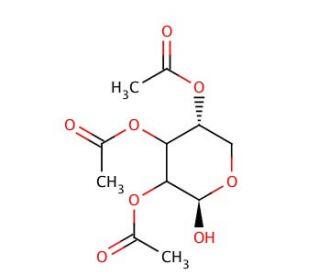

2,3,4-Tri-O-acetyl-D-xylopyranose 의 분자 구조, CAS 번호: 106820-14-8
2,3,4-Tri-O-acetyl-D-xylopyranose (CAS 106820-14-8)
대체 이름:
D-Xylose 2,3,4-Triacetate; 2,3,4-Tri-O-acetyl-D-xylose
적용:
2,3,4-Tri-O-acetyl-D-xylopyranose 는 D-자일로피라노스 계열의 합성에 사용됩니다: 트리-O-아세틸-D-자일로스 및 클로로아세틸 유도체.
CAS 등록번호:
106820-14-8
분자량:
276.24
분자식:
C11H16O8
연구용으로만 사용가능합니다. 진단이나 치료용으로 사용불가합니다.
* Refer to Certificate of Analysis for lot specific data.
빠른 링크
주문정보
설명
기술정보
안전정보
SDS 및 분석 증명서
2,3,4-Tri-O-아세틸-D-자일로피라노스는 탄수화물 화학 연구에서 중요한 화합물로, 복잡한 당의 합성과 변형에 대한 통찰력을 제공합니다. 이 화학 메커니즘은 자일로피라노스 고리의 특정 수산기를 보호하여 선택적 당화 반응과 다양한 탄수화물 구조의 구성을 가능하게 합니다. 연구자들은 이 화합물을 활용하여 자일로스 함유 올리고당의 구조적 및 기능적 특성을 탐구하고 세포-세포 인식, 세포 신호 전달, 숙주-병원체 상호작용과 같은 생물학적 과정에서의 역할을 규명합니다. 또한 2,3,4-Tri-O-아세틸-D-자일로피라노스는 다양한 글리코콘쥬게이트 및 글리코시드 연결의 전구체 역할을 하여 당생물학, 면역학 및 생체 재료 과학에 응용하기 위한 글리코어레이 및 당물질 개발에 기여하고 있습니다. 탄수화물-단백질 상호작용, 효소 특이성, 탄수화물 기반 표적에 대한 연구로 확장되어 새로운 탄수화물 기반 약물 및 백신의 설계에 귀중한 통찰력을 제공합니다. 전반적으로 탄수화물 생물학에 대한 이해와 분자 생물학에서 재료 과학에 이르는 다양한 연구 분야에 미치는 영향을 발전시키는 데 중요한 역할을 하고 있습니다.
2,3,4-Tri-O-acetyl-D-xylopyranose (CAS 106820-14-8) 참고자료
- 팔라듐 촉매에 의한 벤질화된 알도스 헤미아세탈의 락톤으로의 산화. | Bessmertnykh, A., et al. 2004. Carbohydr Res. 339: 1377-80. PMID: 15113678
- D-자일로스의 알케닐 및 알케노일 양친매성 유도체와 그 계면활성제 특성. | Damez, C., et al. 2007. Carbohydr Res. 342: 154-62. PMID: 17182017
- 팔라듐 촉매에 의한 부타디엔과 폴리올의 텔로미어화: 단당류에서 다당류로. | Bouquillon, S., et al. 2010. Top Curr Chem. 295: 93-119. PMID: 21626741
- 천연 이당류 삼부비오스의 총합성. | Lucarini, S., et al. 2020. Pharmaceuticals (Basel). 13: PMID: 32824527
- 1-베타-D-아라비노푸라노실티민의 편리한 합성. | Keller, F. and Tyrrill, AR. 1966. J Org Chem. 31: 1289-91. PMID: 5907873
- 뉴클레오시드 및 관련 물질. V. 탈수제로서 오산화 인을 사용하는 뉴클레오사이드의 합성 절차. | Onodera, K., et al. 1966. J Org Chem. 31: 1291-2. PMID: 5907874
- 2,7-옥타디엔일 배당체에 대한 편리한 경로로서 트리-O-아세틸화된 펜토스를 갖는 부타디엔의 팔라듐 촉매 텔로머화 | Hénin, F., Bessmertnykh, A., Serra‐Muns, A., Muzart, J., & Baillia, H. 2004. European Journal of Organic Chemistry. 2004(3): 511-520.
- 탄수화물 에스테르와 피라노스에 의해 공동 개시된 락타이드 중합[J]. | Tang, M., Haider, A. F., Minelli, C., Stevens, M. M., & Williams, C. K. 2008. Journal of Polymer Science Part A: Polymer Chemistry. 46(13): 4352-4362.
주문정보
| 제품명 | 카탈로그 번호 | 단위 | 가격 | 수량 | 관심품목 | |
2,3,4-Tri-O-acetyl-D-xylopyranose, 100 mg | sc-213967 | 100 mg | $320.00 |
